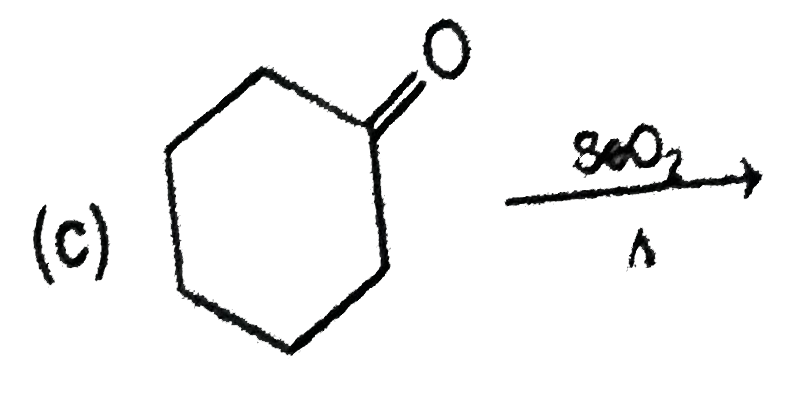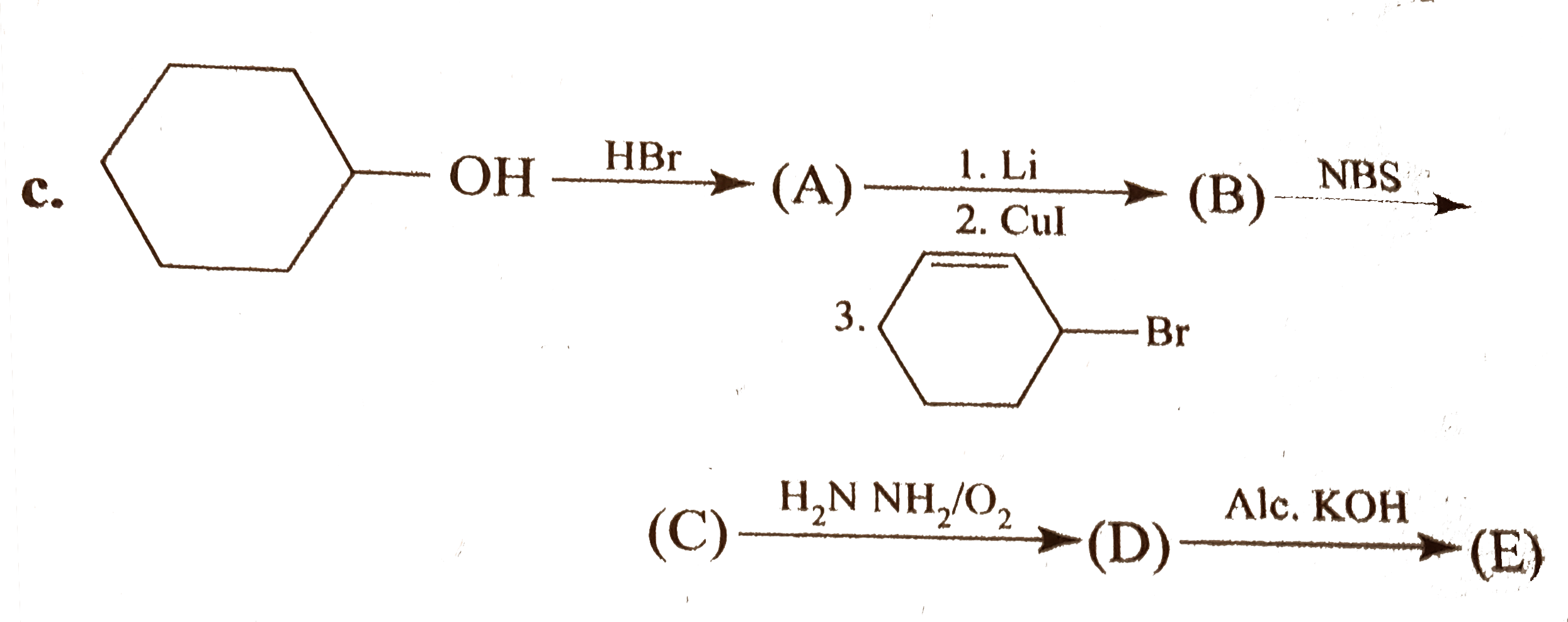Complete the following reaction:
o−HOOC(A)−C6H4−CH2−PhSOCl2−−−→(B)
Anhyd−−−−−−−−−→AlCl3,CH3Cl(C)Zn+Hg−−−−−−−→+HCl(D)
To solve the given reaction sequence, we will follow the steps outlined in the video transcript. Let's break down the reactions step by step.
Step 1: Structure of Compound A
The starting material (A) is described as:
- An ortho-hydroxybenzoic acid (o-HOOC) attached to a phenyl group (Ph) via a methylene (-CH2-) group.
The structure can be represented as:
HOOC∣C6H4−CH2−Ph
Step 2: Reaction with SOCl2
When compound A reacts with thionyl chloride (SOCl2), the hydroxyl group (-OH) of the carboxylic acid is replaced by a chlorine atom (-Cl), forming an acyl chloride. The methylene and phenyl groups remain unchanged.
The reaction can be summarized as:
A+SOCl2→B
Where:
B=C6H4−CH2−Ph−COCl
Step 3: Friedel-Crafts Alkylation with AlCl3 and CH3Cl
Next, compound B undergoes Friedel-Crafts alkylation in the presence of anhydrous AlCl3 and methyl chloride (CH3Cl). The acyl chloride (-COCl) is a meta-directing group, while the methylene group (-CH2Ph) is ortho/para-directing. Therefore, the alkylation will occur at the ortho or para position relative to the methylene group.
The product (C) can be represented as:
C=C6H4−CH2−Ph−COCl−CH3
This results in two possible products due to the ortho and para positions, but we will consider one representative structure for simplicity.
Step 4: Reduction with Zn and HCl
Finally, compound C is subjected to a reduction using zinc amalgam (Zn + Hg) and hydrochloric acid (HCl). This reaction is known as the Clemmensen reduction, which reduces the acyl chloride (-COCl) to a methylene (-CH2-) group.
The final product (D) can be summarized as:
D=C6H4−CH2−Ph−CH3−CH2
Summary of the Reaction Sequence:
1. Starting Material (A): o-HOOC - C6H4 - CH2 - Ph
2. After Reaction with SOCl2 (B): C6H4 - CH2 - Ph - COCl
3. After Friedel-Crafts Alkylation (C): C6H4 - CH2 - Ph - COCl - CH3
4. After Clemmensen Reduction (D): C6H4 - CH2 - Ph - CH3 - CH2
The starting material (A) is described as:
- An ortho-hydroxybenzoic acid (o-HOOC) attached to a phenyl group (Ph) via a methylene (-CH2-) group.
HOOC∣C6H4−CH2−Ph
When compound A reacts with thionyl chloride (SOCl2), the hydroxyl group (-OH) of the carboxylic acid is replaced by a chlorine atom (-Cl), forming an acyl chloride. The methylene and phenyl groups remain unchanged.
A+SOCl2→B
Where:
B=C6H4−CH2−Ph−COCl
Next, compound B undergoes Friedel-Crafts alkylation in the presence of anhydrous AlCl3 and methyl chloride (CH3Cl). The acyl chloride (-COCl) is a meta-directing group, while the methylene group (-CH2Ph) is ortho/para-directing. Therefore, the alkylation will occur at the ortho or para position relative to the methylene group.
C=C6H4−CH2−Ph−COCl−CH3
This results in two possible products due to the ortho and para positions, but we will consider one representative structure for simplicity.
Finally, compound C is subjected to a reduction using zinc amalgam (Zn + Hg) and hydrochloric acid (HCl). This reaction is known as the Clemmensen reduction, which reduces the acyl chloride (-COCl) to a methylene (-CH2-) group.
D=C6H4−CH2−Ph−CH3−CH2
1. Starting Material (A): o-HOOC - C6H4 - CH2 - Ph
2. After Reaction with SOCl2 (B): C6H4 - CH2 - Ph - COCl
3. After Friedel-Crafts Alkylation (C): C6H4 - CH2 - Ph - COCl - CH3
4. After Clemmensen Reduction (D): C6H4 - CH2 - Ph - CH3 - CH2
Topper's Solved these Questions
- AROMATIC COMPOUNDS AND ALKYL AND ARYL HALIDES BOOK - CENGAGE CHEMISTRY ENGLISHCHAPTER - AROMATIC COMPOUNDS AND ALKYL AND ARYL HALIDES EXERCISE - Solved Examples
21 Videos
- AROMATIC COMPOUNDS AND ALKYL AND ARYL HALIDES BOOK - CENGAGE CHEMISTRY ENGLISHCHAPTER - AROMATIC COMPOUNDS AND ALKYL AND ARYL HALIDES EXERCISE - Solved Problems
37 Videos
- APPENDIX INORGANIC VOLUME 2BOOK - CENGAGE CHEMISTRY ENGLISHCHAPTER - APPENDIX INORGANIC VOLUME 2EXERCISE - Short Answer Type
179 Videos
- BIOMOLECULESBOOK - CENGAGE CHEMISTRY ENGLISHCHAPTER - BIOMOLECULESEXERCISE - Exercises Archives (Analytical And Descriptive)
8 Videos
Similar Questions
Fill in the blanks with appropriate structure of reaction products in the following trasformation:
HOOC−C6H4−CH2−C6H5SOCl2−−−→Aanlydrous−−−−−→AlCl3BZn−Hg−−−−→HClC
View SolutionComplete the following reaction CH3−C∣CH3=CH−CH3H2,Ni−−−→?
View SolutionComplete the following reactions:
Propane nitrile(N)(i)PhMgBr−−−−−−−−−→(ii)H3O⊕(O)Zn−Hg−−−−−−−→HCl(P)
View SolutionComplete the following reactions :
(a) Ph−CH2−CH2−OHCu/Δ−−−→, (b) Ph−CH∣OH−CH3Cu/Δ−−−→, (c) Ph−CH3∣C∣CH3−OHCu/Δ−−−→
View SolutionF3C−CH=CH2HBr−−→(A)Nal−−−−−−−−−→dry.acetone(B)
View SolutionComplete the following
(a) CH3−CHOSeO2−−→Δ, (b) H3C−CH2−O∣∣C−CH3SeO2−−→Δ, (c)
View Solutioncomplete the following reactions:
a. C6H6+MeCOCIBenze≠(A) AICI3−−−→ B HNO3––––––H(2)SO4)→ C NaBH4−−−−→ D H2SO4−−−→Δ E
View SolutionComplete the following reactions :
a. (F)+D←−−(E)1.Li←−−−2.Cul(D)HBr←−−CH3CH=CH2NBS−−→(A)NBr−−−−→RCOOR(B)Mg−−→(C)
b. CH3CH=CH−CH32NBS−−−→(A)2Ic−−−→(B)H2NNH2/O2−−−−−−−−→(C)
c.
View SolutionProducts of the following reaction are
CH3−C∣CH3=CH−CH3KMnO4/H−−−−−−−−−→
View SolutionComplete the following reactions
CH3CH=CH2mCPBA−−−−→AC2H5MgBr−−−−−−→H3O+B
View Solution
